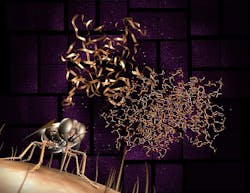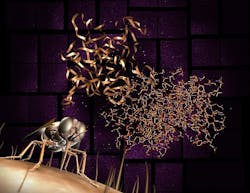X-ray laser helps destroy sleeping sickness parasite
An international team of scientists, using the worldâs most powerful x-ray laser, has revealed for the first time the 3D structure of a key enzyme that enables the single-celled parasite that causes African trypanosomiasis (sleeping sickness) in humans.
With the elucidation of the 3D structure of the cathepsin B enzyme, it will be possible to design new drugs to inhibit the parasite (Trypanosoma brucei) that causes sleeping sickness, leaving the infected human unharmed.
"These images of an enzyme, which is a drug target for sleeping sickness, are the first results from our new âdiffract-then-destroyâ snapshot x-ray laser method to show new biological structures which have not been seen before,â explains John Spence, Arizona State University (ASU; Tucson, AZ) Regentsâ Professor of Physics. âThe work was led by the DESY (German Electron Synchotron) group and used the Linac Coherent Light Source at the U.S. Department of Energyâs SLAC National Accelerator Laboratory."
Transferred to its mammalian host by the bite of the tsetse fly, the effects of the parasite are almost always fatal if treatment is not received. The sleeping sickness parasite threatens more than 60 million people in sub-Saharan Africa and annually kills an estimated 30,000 people. Current drug treatments are not well tolerated, cause serious side effects, and the parasites are becoming increasingly drug-resistant.
The work is based on nanocrystals grown by the groups at DESY in Hamburg and at the University of Lübeck inside living insect cells, explains Petra Fromme, a professor in ASUâs Department of Chemistry and Biochemistry. âThis is the first novel structure determined by the new method of femtosecond crystallography. The structure may be of great importance for the development of new drugs to fight sleeping sickness, as it shows novel features of the structure of the CatB protein, a protease that is essential for the pathogenesis, including the structure of natural inhibitor peptide bound in the catalytic cleft of the enzyme,â she adds.
An additional difficulty includes the fact that the cathepsin B enzyme is also found in humans and all mammals. However the discovery of the enzymeâs 3D structure has enabled the researchers to pinpoint distinctive structural differences between the human and the parasiteâs form of the enzyme. Subsequent drug targets can selectively block the parasiteâs enzyme, leaving the patientâs intact.
The ASU group developed the sample delivery system, worked on the characterization of the crystals with dynamic light scattering and SONNIC, and did the early development work on the new data analysis method. All ASU participants are members of the College of Liberal Arts & Sciences.
The work appears in Science; for more information, please visit http://www.sciencemag.org/content/early/2012/11/28/science.1229663.
-----
Follow us on Twitter, 'like' us on Facebook, and join our group on LinkedIn
Laser Focus World has gone mobile: Get all of the mobile-friendly options here.
Subscribe now to BioOptics World magazine; it's free!

